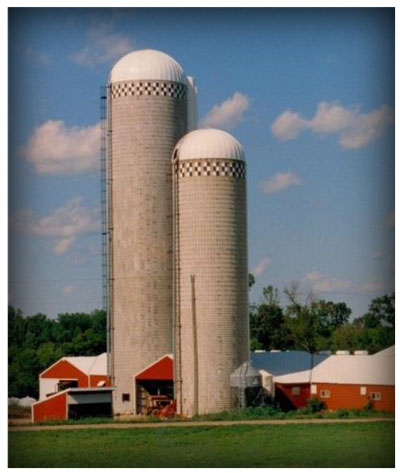When properly managed and cared for, upright silos provide excellent storage for fermented feeds. By combining the use of gravity for tight forage packing and a small area exposed to air, forage quality is preserved and waste is minimal. However, when poorly maintained they can quickly become a headache. There are also serious dangers associated with upright silos that are not structurally sound, which can crumble and collapse, not to mention the hazards of unloaders and the risk of silo gases after harvest. To get the most benefit out of your upright silo, it is critical to maintain it and prepare it before each harvest.
The following should be checked yearly:
- Examine the unloader for signs of wear and tear. Replace cables if necessary and take time to check bearings, drives, and other moving parts for condition. Check lifting equipment for soundness. Make sure to consult the owner’s manual for suggested maintenance and adjustments. The International Silo Association is another great source of information for silo upkeep. Visit them at http://www.silo.org/.
- For safety, check ladders and cages for proper attachment and condition.
- Floor drains should be open and debris should be removed from silo surroundings to prevent accumulation of moisture in silo walls.
- Check latches and hinges for corrosion. Again, tighten up anything that has become loose.
- Doors should all be in good condition. Check for rot and physical damage.
- Make sure doors still seal to keep air out. Air is the enemy of proper fermentation!
- Inspect bolts and bolt heads for corrosion. Take this time to tighten any that have loosened.
- Check concrete frames around doors for any physical damage. Make sure that the door sits properly into frame.
- Ensure that the distributor is functioning properly. If it is in proper working order
it should fill the silo uniformly which will enhance packing of forage and increase the capacity of the silo. A good distributor can increase silo capacity by as much as 30%. If you observe forage filling quicker on one side or that silage is mounding, contact your silo equipment supplier for assistance. - Maintain silo liners. The acids produced by ensiling feeds can be quite corrosive and have the capacity to eat away at cement. Inspect the lining of the silo to ensure that it has not been deteriorated. If a new liner is needed, a skilled contractor should be contacted for input on selection and application of the appropriate liner material.
- Harvesting forage at the appropriate dry matter will prevent excess seepage from the stored feed. This should help with maintaining the integrity of the silo base increasing its longevity (Table 1).
- Keep adults, children, and animals clear of the silo gas that can be found in and around the silo during the fermentation phase. Silo gas is exceedingly dangerous. If entering the silo is necessary for any reason after it has been filled make sure to run the blower for a minimum of 30 minutes before entering and continue its use until exit. The gases produced during fermentation can and have caused deaths.
- When it comes to removal of forage remember to remove at least:
- 2 in/day for alfalfa and corn silage in cold weather
- 3 – 4 in/day alfalfa and 4 – 6 in/day corn silage in warm weather

Information adapted from:
Managing Forage in Tower Silos http://fyi.uwex.edu/forage/files/2014/01/ManagingTowerSilos.pdf
This Old Silo http://www.ansci.cornell.edu/pdfs/pdconcretetowersilo.pdf
| Silo Diameter (ft) | |||||
|---|---|---|---|---|---|
| Silo Height (ft) | 10 | 15 | 20 | 25 | 30 |
| 20 | 78 | 76 | 74 | 74 | 74 |
| 30 | 76 | 72 | 71 | 70 | 69 |
| 40 | 74 | 70 | 68 | 66 | 65 |
| 50 | — | 68 | 66 | 63 | 62 |
| 60 | — | 67 | 63 | 61 | 60 |
| 70 | — | — | — | 59 | 57 |
| 80 | — | — | — | 57 | 54 |
Table 1. Recommended maximum moisture content to decrease seepage from upright silos (adapted from Managing Forage in Tower Silos).
Upright Silos
Famo Feeds • 446 Industrial Dr • Freeport, MN • 800-450-2145

